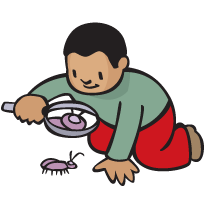Boston Children's Museum
308 Congress Street, Boston, MA 02210
617-426-6500
© Boston Children’s Museum 2024
Website Design by JackrabbitWherever you live, a surprising array of living things occupies the same space. In the city, in the country, in the suburbs…many species of bird, mammal, reptile, amphibian, insect and other organisms can be found if you take the time to look. Giving kids the chance to do an inventory of these creatures not only familiarizes them with living things and classification, but instills in them a sense of place and an understanding of and appreciation for their home environment.
Gather all materials and show children how to use the magnifying glasses, rulers and binoculars, etc.

Before going outside for the first time, ask your children to help you brainstorm a list of the living creatures they think they might find outside your building. Where might they look to find these critters? What should they do when they encounter them? Tell them that rather than collecting and keeping the animals, they’ll be making drawings of them. In some instances (for example, worms, pillbugs, etc.), they might temporarily contain a critter in one of the “bug boxes” you’ve provided in order to get a better, more studied look at them. Tell children that they’ll need to come and find you before they capture anything, and use your discretion in deciding whether it’s OK to contain the critter they’ve found. And make sure to let it go when the child is finished drawing!
How many living things can you find around your afterschool?
Students can work individually or in pairs for this activity. Make sure that the kids are armed with drawing materials, and send them off to find living things. Stress how important it is that they are gentle with and respectful of any living things that they find. Try to discourage handling any living creature (we’re talking worms and bugs here…NEVER try to handle any birds, mammals, reptiles, or fish). If capturing a critter is necessary in order to observe it, show children how to scoop it up with the bug box, being careful not to hurt the animal.
After 10-15 minutes of searching, stop your students and bring them together to share their observations with each other. What have they found? Where did they find them? Was anyone surprised by what they found or didn’t find? This discussion should last no more than 5 minutes.
Send them back to search and draw again, encouraging multiple drawings. Once the session is done, collect the drawings and save them. If you do this activity multiple times, these drawings can be used to create a “living memory” or a field guide of the kinds of animals that live around your afterschool center.